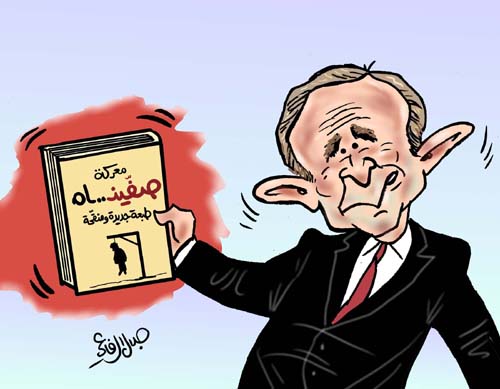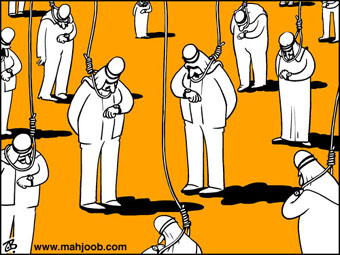La Jornada,
Mexico
Saddam's Hanging a New Chapter in America's Defilement
“As if from a B-movie script, Saddam 'knew too much.' ... the United States needed to eliminate the most important witness to their war crimes.”
By Alejandro Nadal
Translated By Barbara Howe
January 3, 2006
Mexico - La Jornada - Original Article (Spanish) 
 'Executing Saddam is part of George Bush's relentless effort to
'Executing Saddam is part of George Bush's relentless effort to
resurrect the 7th Century conflict between Shiites and Sunnis.
The goal: Divide and rule.'
[Ad Dustour, Jordan].
—AMATEUR VIDEO: Saddam's execution
via cell phone, Dec. 29, 00:02:36
 [NEWSWIRE PHOTOS: Saddam Hussein].
—BBC VIDEO NEWS: Saddmam buried near
[NEWSWIRE PHOTOS: Saddam Hussein].
—BBC VIDEO NEWS: Saddmam buried near
hometown of Tikrit, Dec. 30, 00:03:28 'Arab rulers await execution after Saddam's hanging.'
'Arab rulers await execution after Saddam's hanging.'
[Alquds Alarabi, U.K.]

 Iraqi Prime Minister Nuri al-Maliki has lashed out at critics
Iraqi Prime Minister Nuri al-Maliki has lashed out at critics
of his government's handling of Saddam Hussein's execution,
threatening to review relations with countries that raise the issue.
—BBC VIDEO NEWS: Prime Minister Nuri al-Maliki
tells other countries to 'mind their own business,'
Jan. 6, 00:01:54 A man kisses a huge picture of Saddam Hussein, on display in
A man kisses a huge picture of Saddam Hussein, on display in
the Iraqi town of Al-Howeish, Jan. 6. The manner of the dictator's
death has given his legacy new cache.
 ------------------------------------------------------------------------------
------------------------------------------------------------------------------
To finish off the year, there two bits of new arrived: Saddam
Hussein was executed and the 3,000th U.S. soldier died in the war. The deposed dictator had long ago stopped
being an essential point of reference for Iraqis. So the relevance of the 29th of December was
simply the symbolism of an execution that confirms the vicious circle of
violence in Iraq.
It would have been more accurate to say that Saddam was
assassinated. The masks worn by those entrusted with eliminating him were bad disguises
for agents of justice. Perhaps it was of some use for those charged with liquidating
him to dress as executioners, but it couldn't hide the motive for the murder: to
eliminate a compromising witness. As if from a B-movie script, Saddam "knew
too much."
Only he knew the names of the companies that sold him chemical
weapons to bomb Kurdish towns and Iranian troops. He knew the names of the officials
in Washington and Brussels that authorized the sale of weapons and materiel
during the 1980s - despite the restrictions on the weapons trade in the Middle
East. He also knew the agents that provided him with satellite images of enemy positions
during the war with Iran, which cost over a million lives.
Saddam would have been a formidable witness for the prosecution
regarding crimes perpetrated by the United States across the entire region for
the past 20 years. For that reason, it was unthinkable to allow him to suffer
the fate of Slobodan Milosevic, the deposed president of Serbia, and send him
to be judged by an international Court in The Hague. There are plenty of technical arguments to
justify international prosecution, but the United States preferred that he be
judged by their puppets in Baghdad. Otherwise, Saddam would have spoken freely of the past, to delight the international press.
Henry Kissinger has been known to say that it's more dangerous to
be an ally to the United States than to be its enemy. He was right and Saddam can
confirm it. The hooded henchmen in charge of eliminating him - like members of a
cell working for the-now-forgotten al-Zarqawi, explained to him how his neck
would crack as he fell through the trap door. But they had no need to explain
what he already knew: the United States needed to eliminate the most important
witness to their war crimes. At Nuremberg trials after World War II, even the Nazi
criminals were judged by an international tribunal. But in Baghdad, the United
States has just set a degrading precedent.
At any rate, few shed tears over his execution. Hussein was a bloodthirsty dictator with the deaths
of many thousands of people on his hands. But the death sentence imposed after a trial mounted by an invading
power has nothing to do with justice. And yes, this once again reveals the
taste for capital punishment in the United States. It's an old idea very strongly rooted in the
country: it's alright to kill someone if one feels that it's the right thing to
do. This is how vengeance disguises itself as justice.
The execution of Saddam Hussein inside Baghdad's super-fortified
Green Zone is another ostentatious scene in the bad script that is Washington's
adventure in Iraq. The United States still has no strategy for its crazy war. The
only thing that exists in Bush's feeble mind are props
in this mediocre screenplay. That's why he thinks that everything can be solved
with staged episodes like his apparent landing on the air carrier USS
Abraham Lincoln dressed up as a combat pilot. What will be the next act in
this tragic comedy?
It's reasonable to believe that the architects of the Iraq invasion
thought that instability in the region would be so great that no one in the United
States would dare to recommend withdrawal. This has already been proven wrong. In the beginning of December, the
Iraq Study Group, headed by Bush ally James Baker, presented the results of
their analysis: the United States should begin to withdraw its troops by 2008.
On the other hand, the White House has other plans: to increase
the U.S. military presence in Mesopotamia. They aren't discussing an "escalation" as they did during
Vietnam, but rather a "temporary surge" in reinforcements to their
floundering imperial troops. The number 30,000 is being tossing about "for
a period of six months." It's
possible the announcement will be made by the new Defense Secretary Robert Gates,
an official that has spent his life carrying water for his superiors. Or perhaps Bush himself will make the announcement
as his advisors whisper in his ear that the war can "be won."
One thing is incontrovertible: in Washington no one knows what to
do in Iraq. Meanwhile, a slipknot is closing inexorably on the imperial
adventure.
Spanish Version Below
Nudo corredizo en Irak
Para terminar el año llegaron dos noticias: Saddam fue ejecutado y
murió el soldado estadunidense número 3 mil en la guerra. El
depuesto dictador había dejado de ser una referencia importante para los
iraquíes desde hace mucho. Así que lo relevante el 29
de diciembre fue el simbolismo de una ejecución que confirma el círculo vicioso
de la violencia en Irak.
Hubiera sido más certero decir que Saddam fue asesinado. Las máscaras de los
encargados de eliminarlo constituyeron un mal disfraz
de justicia. Quizás sirvieron para vestir como verdugos a los encargados de liquidarlo, pero no para esconder el móvil del
asesinato: eliminar un testigo comprometedor. Como en
cualquier guión de película de mala calidad, Saddam Hussein "sabía
demasiado".
Sólo él conocía los nombres de las compañías que le
vendieron las armas químicas para bombardear a los pueblos kurdos y las tropas
de Irán. El sabía los nombres de los funcionarios en Washington y Bruselas
que autorizaron las ventas de material de guerra durante los años 80 a pesar de las restricciones sobre comercio de armas en el Medio
Oriente. También estaba enterado del nombre de los
agentes que semanalmente le proporcionaron imágenes de satélite sobre las
líneas enemigas durante la guerra con Irán que cobró más de un millón de
muertes.
Saddam hubiera sido un formidable testigo
de cargo sobre los crímenes perpetrados por Estados Unidos en toda la región en
los pasados 20 años. Por eso era impensable hacerle correr la suerte de
Slobodan Milosevic, el depuesto presidente de Serbia, y enviarlo para ser
juzgado por un tribunal internacional en La Haya.
Sobraban argumentos técnicos que justificaban un juicio internacional, pero Estados Unidos prefirió que lo juzgaran sus títeres
en Bagdad. De lo contrario, Saddam habría soltado la lengua
para deleite de la prensa internacional.
Alguna vez Henry Kissinger afirmó que era más peligroso
ser aliado de Estados Unidos que enemigo. Tenía razón y Saddam
Hussein lo pudo comprobar. Los esbirros encapuchados encargados de
liquidarlo, como miembros de cualquier célula del
olvidado al-Zarqawi, le explicaron cómo tronaría su pescuezo en el patíbulo.
Pero no tuvieron que explicarle lo que ya sabía: Estados Unidos necesitaba
eliminar al testigo más importante de sus crímenes de guerra. En los juicios de
Nuremberg después de la segunda guerra mundial, hasta los criminales nazis tuvieron un juicio supervisado por un tribunal
internacional. En cambio, en Bagdad, Estados Unidos acaba de sentar un precedente tan peligroso como denigrante.
De todas maneras, pocos derramaron lágrimas al conocer la
ejecución. Hussein fue un sanguinario dictador con
la muerte de cientos de miles de personas a cuestas. Pero la pena de muerte impuesta después de un juicio montado por una potencia invasora, no
tiene nada que ver con la justicia. Eso sí, revela una vez más el gusto por la pena capital en Estados Unidos. Es una vieja idea muy
arraigada en ese país: está bien matar a alguien si
uno siente que tiene una buena razón para hacerlo. Es así que
la venganza se disfraza tantas veces de justicia.
La ejecución de Saddam Hussein dentro de la súper fortificada Zona
Verde en Bagdad, es otro acto de relumbrón en ese mal
guión que es la aventura de Washington en Irak. Estados
Unidos no tiene ninguna estrategia para su guerra loca. Lo único que hay
en la febril mente de Bush son actos rodeados de una mediocre escenografía. Por
eso cree que todo puede arreglarse con episodios como
su aterrizaje disfrazado de piloto de combate en el portaviones USS Abraham Lincoln. ¿Cuál
será el próximo acto de esta trágica comedia?
Es una hipótesis plausible que los arquitectos de la invasión de Irak
pensaron que la inestabilidad en la región sería tan grande que nadie en
Estados Unidos se atrevería a recomendar la retirada. Pues ya
se equivocaron. A principios de diciembre el Grupo de Estudio sobre
Irak, un equipo capitaneado por James Baker, amigo de la familia Bush, presentó
el resultado de sus análisis. Después de reconocer que la situación en Irak es
grave y continúa deteriorándose, el equipo formuló su principal recomendación:
comenzar la retirada de tropas estadunidenses a principios de 2008.
A contrapelo, la Casa Blanca tiene otros planes: aumentar la
presencia militar en Mesopotamia. No se habla de escalada, como en los tiempos de Vietnam, sino de un "pico temporal" en el envío de
refuerzos a las atribuladas tropas imperiales. Ya se está manejando la cifra de
unos 30 mil soldados adicionales "durante un
periodo de seis meses". Es posible que el anuncio lo haga el nuevo jefe del Pentágono, Robert Gates, un funcionario que toda su vida
se la ha pasado haciendo caravanas a sus superiores. Quizás lo anuncie el
propio Bush, aconsejado por asesores que le susurran al oído que esta guerra se
puede "ganar".
Un hecho es incontrovertible: en Washington nadie sabe qué
hacer en Irak. Mientras tanto, un nudo corredizo se
cierra inexorablemente sobre la aventura imperial.